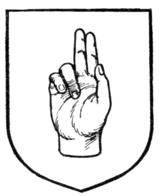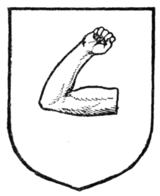170
A COMPLETE GUIDE TO HERALDRY
the elbow, and this is signified by the term "embowed," and an arm embowed necessarily includes the whole arm. Fig. 262 shows the usual position of an arm embowed, but it is sometimes placed embowed to the dexter (Fig. 263), upon the point of the elbow, that is, "embowed fesseways" (Fig. 264), and also, but still more infrequently, resting on the upper arm (Fig. 265). Either of the latter positions must be specified in the blazon. Two arms "counter-embowed" occur in many crests (Figs. 266 and 267).
When the arm is bare it is termed "proper." When clothed it is termed either "vested" or "habited" (Fig. 268). The cuff is very









